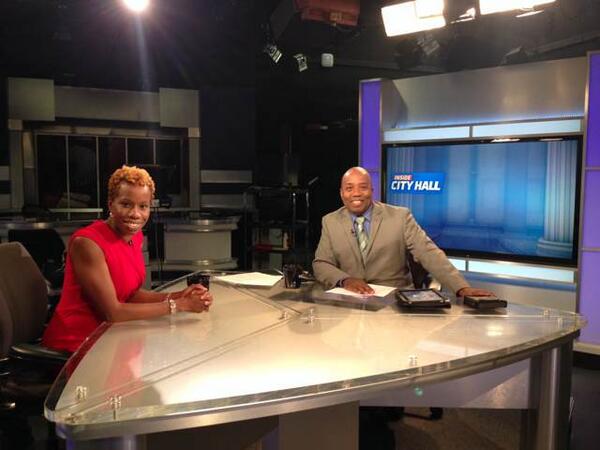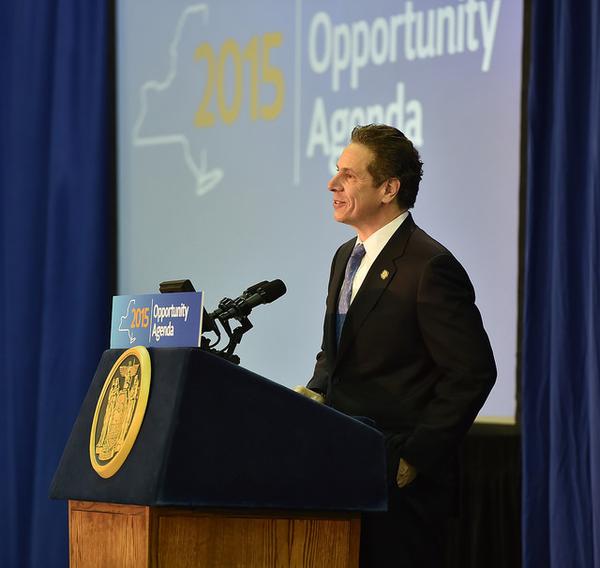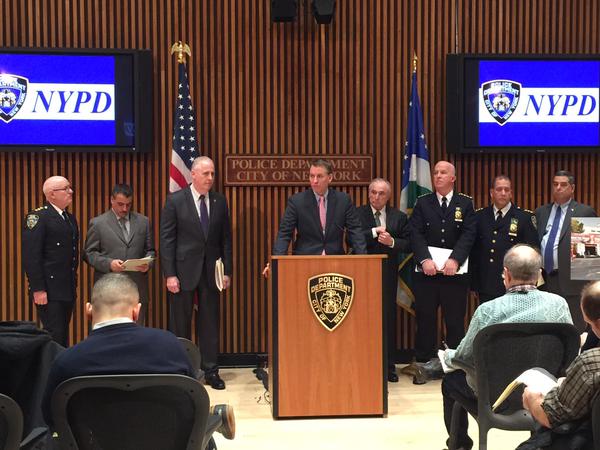Public-Private Partnership Preserves Homes for 2,000 New Yorkers

NYCHA Chair Shola Olatoye, the author, on Inside City Hall (photo: @NYCHA)
The New York City Housing Authority (NYCHA), home to more than 600,000 New Yorkers who live in public housing and Section 8 rentals, is the largest landlord in New York City and the largest public housing authority in the country. As federal support for public housing continues to decline and our properties continue to deteriorate, we must find creative ways to maintain and protect this vital resource for current and future generations.
To that end, NYCHA has formed a public-private partnership, Triborough Preservation Partners, which will provide $80 million in capital work for 875 units of Section 8 housing. Unlike NYCHA public housing, these properties are subsidized by Housing Assistance Payments from HUD. Steady reductions in HUD funding since 2001 has resulted in a deficit of more than $1 billion, making it impossible for NYCHA to keep up with critical repairs at all of its properties. In addition, the project-based Section 8 developments are ineligible for federal capital funding. This scarcity of funding has taken its toll – all told, the six developments need about $48 million of capital work over the next five years, and about $113 million over the next 15 years.
Limited government investment demands that we become creative about solutions to urgent problems, in particular, the infrastructure needs of our properties. Project-based Section 8 regulations allow NYCHA to partner with private entities to support capital repairs and rehabilitation without giving up our control or ownership of those properties. In fact, the affordable housing industry – and Public Housing Authorities in places like White Plains, St. Louis, and Miami – have leveraged private funds to preserve their buildings for residents for more than 30 years.
These project-based Section 8 units – located at Bronxchester Houses, Saratoga Square, Campos Plaza, Milbank-Frawley, East 4th Street, and East 120th Street – will remain Section 8 housing and are subject to rent stabilization regulations. NYCHA retains approval rights over major decisions. Under Section 8, residents' share of the rent will not increase – it will remain at 30 percent of their income.
Our trusted Triborough colleagues are experts in tenant-in-place rehab projects and will do everything possible to minimize the impact of renovation on residents. Repairs will include new kitchens and bathrooms for every apartment, renovated lobbies and community areas, energy-efficient technologies, and security enhancements. In the event that a resident must be relocated, the relocation will be temporary and at no cost to the resident. Additionally, Triborough has committed to training and hiring NYCHA residents for at least 20 percent of the construction work and 50 percent of the maintenance workforce for at least $15 an hour. So far, 21 NYCHA residents have been hired for these jobs.
In total, we expect this partnership to generate a return to NYCHA of approximately $360 million over the next 15 years, vital funds that helped close NYCHA's 2014 operating deficit and will fund capital work at our public housing developments as well.
This partnership is a win for everyone. Residents of the six developments will quickly benefit from completed repairs and enhanced living conditions. NYCHA residents across the five boroughs have another source of training and employment. New Yorkers can be assured that public housing – including project-based Section 8 housing – remains a valuable asset and a trusted resource for not just this generation, but also the next generation of New Yorkers.
At NYCHA we are committed to not just sustaining public housing for the future, but in making it better – not just painting over the problems, but creating safe, clean, and connected communities wherever there are NYCHA developments.
***
Shola Olatoye is Chair and CEO of NYCHA.
***
Have an op-ed idea or submission for Gotham Gazette? E-mail editor Ben Max: This email address is being protected from spambots. You need JavaScript enabled to view it.
Time to Pass the Homeless Protection Act

Gov. Cuomo outlining his 2015 agenda (photo: @NYGovCuomo)
On Saturday morning, in yet another example of the growing trend of attacks on homeless individuals, a traveler at the Newark Liberty International Airport beat a 62-year-old homeless man. The victim, a client in the Urban Pathways Newark Airport Outreach Program, was sleeping when he was attacked. The perpetrator put an innocent man in the hospital with serious injuries. He also potentially disrupted the trust and comfort that the victim developed during outreach, which is so critical to moving him from the street into housing.
Attacks like these against homeless persons appear to be growing in number and severity. In recent days, a homeless man sleeping under a New York City bridge reportedly had his mattress set afire. Last year, a homeless man sleeping on the steps of a Bronx church, a place he often slept because he told the priest that he felt safer at the church, was beaten to death. These are among hundreds of attacks on the homeless that occur each year.
As we work to help the homeless, among the most vulnerable in our society, find stable housing, we must also act to protect their well-being.
New York State should pass the "Homeless Protection Act" (A.1353 and S.813). Stalled in the Legislature for the past six years, the Act would designate certain offenses against the homeless as hate crimes, protecting them from future violence and abuse. Passing the legislation could also raise consciousness about the stigmatization problem at the heart of this issue. If the number of attacks are as high as advocates contend, statistics will open eyes and hopefully cause a long overdue response, further helping homeless individuals move off the streets and into self-sufficiency.
Organizations across the New York City metropolitan area, such as Urban Pathways and Care for the Homeless, provide outreach services to the street homeless, attempting to engage the most difficult to reach. Outreach staff engage homeless individuals on the streets and at transit hubs, "where they are at," and offer case management and referrals to move individuals from the street into housing and treatment programs in order to minimize the chance of a return to the streets.
For the past 15 years, the National Coalition for the Homeless has issued an annual report, documenting the increasingly frequent and severe violence against the homeless by housed individuals. The Coalition report, largely based on media reports, recorded 1,437 attacks and 357 deaths nationally from 2009 to 2013. Precise data on the attacks doesn't exist, since they are often not reported or when reported, not recorded. Attacks as extreme as setting a victim on fire, and videotaping attacks to post online, only further encourage the mistreatment of the homeless.
Homeless people, or those perceived as homeless, are not usually targeted for robbery; they have too few monetary resources for that. According to the Coalition report, perpetrators either have no explanation for the attack or claim they attacked those so in need because they were so vulnerable – so easy – to victimize. Homeless advocates and social scientists often cite "stigmatization" as the base cause. In the ultimate "blame the victim" phenomenon, the poorest among us, are further stigmatized and dehumanized.
A national effort to address this disturbing trend in attacks against the homeless is underway. Poverty and social justice advocates are working to include people attacked because they are homeless, or perceived to be homeless, under hate crime laws. In January, Cincinnati became the third U.S. city to provide hate crimes protection to the homeless. New York State can and must make a major statement by passing the Homeless Protection Act this year.
***
Nicole Bramstedt is the Policy Analyst at Urban Pathways and Jeff Foreman is Policy Director at Care for the Homeless.
***
Have an op-ed idea or submission for Gotham Gazette? E-mail editor Ben Max: This email address is being protected from spambots. You need JavaScript enabled to view it.
'Broken Windows:' Immoral, Ineffective, & Out of Time

NYPD leaders discuss crime (photo: @NYPDNews)
Even with the publicized results of the recent work slowdown by officers — cops stopped arresting and ticketing people for minor infractions and crime went into a steep decline — Mayor de Blasio continues to defend 'broken windows' policing. A serious moral and political lapse by the city's most progressive mayor in at least 20 years.
The NYPD's quota-driven, 'broken windows' practices target low-level, often innocuous activities like carrying an open alcohol container, walking between subway cars, begging, and jaywalking. A mockery of justice, now exposed in an "emperor has no clothes" moment as ineffective, 'broken windows' policing everyday inflicts harm and hardship on hundreds, if not thousands, mostly low-income people of color. This stark racial bias which includes the aggressive bullying of marginalized groups like the homeless, sex workers, the mentally ill, street vendors, and LGBT youth prevails without, for the most part, organized opposition or outcry from any quarter, including the good people working within the system. Relevant are the telling words from Martin Luther King Jr., whose birthday we just celebrated: "In the end we will remember most not the voices of our enemies but the silence of our friends."
The daily racial bias and injustice of the system is undeniable. Here are sample statistics that we have culled from the NYPD and other government agencies that indicate how 'broken windows' is enforced and why it must end:
-From 2008-2011, the police issued an average of eight bike-on-the-sidewalk summonses in Park Slope, Brooklyn. During the same time period, for these kinds of tickets the annual average in Bedford-Stuyvesant, Brooklyn was 2,050.
-For the first 9 months of 2014, the NYPD made 174,823 misdemeanor arrests (648 per day), 86.2 percent involving people of color. Despite the fact that a new administration began in 2014, these figures represent a remarkably similar pattern to the arrest practices of the same span in 2013 when the numbers were 173,625 arrests, 87% involving people of color.
-95 percent of the people incarcerated on Rikers Island are black or Hispanic, confined because of two main factors: the NYPD arrested and locked them up; and they were too poor to make bail.
-In 2011, the height of the NYPD's use of stop-and-frisk, black and Hispanic males between the ages of 14 and 24 accounted for 41.6 percent of stops even though they are only 4.7 percent of the city's population. The number of stops of young black men in 2011 exceeded the entire city population of young black men — 168,126 stops compared to 158,406 people.
Compounding the harm done by 'broken windows' policing are the collateral consequences of these petty arrests and summonses: loss of one's job or time at work, denial of access to scholarships or public housing, loss of child custody, even deportation in some cases. More than any current government policy or practice, 'broken windows' causes and reflects the everyday social, economic, and racial inequities that afflict our city. 'Broken windows' policing and its consequences represent "a tale of two cities" writ large.
New York City cannot have two different criminal justice systems.
The significance of now, of this moment is that it is the first time in the city's history that the issue of abusive and biased policing is front and center in the political landscape and the policy debate. Previous outcries focused on egregious incidents of police brutality and excessive force such as the shooting deaths of Amadou Diallo and Sean Bell. Never before has there been a sustained and highly visible movement aimed at exposing and correcting the daily systemic practices that compromise the lives and well-being of people, practices that serve to devalue the worth and lives of black and Hispanic people and create the circumstances wherein it is inevitable that fatalities occur at the hands of police officers.
In sum, here's the bad news: these terrible and unjustifiable practices have persisted for decades, are indisputably racist and deeply immoral, represent a dark stain on our city's legacy and question its reputation as a diverse and welcoming metropolis.
But here's the good news for Mayor de Blasio and the rest of us: because of the growing attention on this issue; because more and more people outside the community most often victimized are aware of abusive policing and its widespread ill effect;, because the affected constituency is actively mobilized in the movement for sweeping reforms; and because the NYPD work slowdown has exposed the myth of 'broken windows' as a successful crime reduction strategy — all unprecedented developments — New York City has an historic opportunity to fully redress long-standing injustices and to create public safety measures that bring together community groups, public and non-profit service providers, and law enforcement, and that make significant progress toward establishing a truly inclusive and equitable city. The first step is an end to 'broken windows.'
***
Robert Gangi is the director of the Police Reform Organizing Project (PROP). Find PROP online at its website and on Facebook and Twitter.
***
Have an op-ed idea or submission for Gotham Gazette? E-mail editor Ben Max: This email address is being protected from spambots. You need JavaScript enabled to view it.




